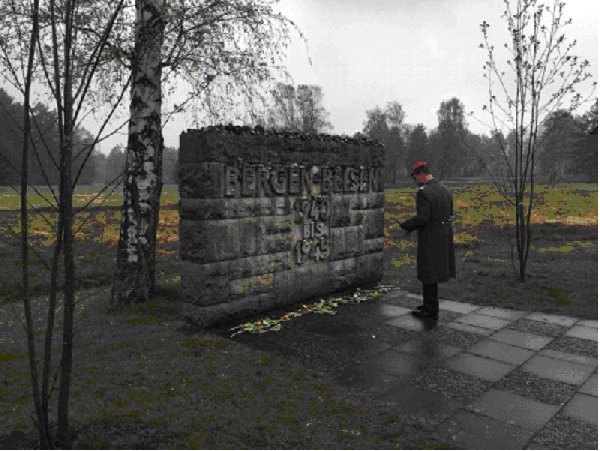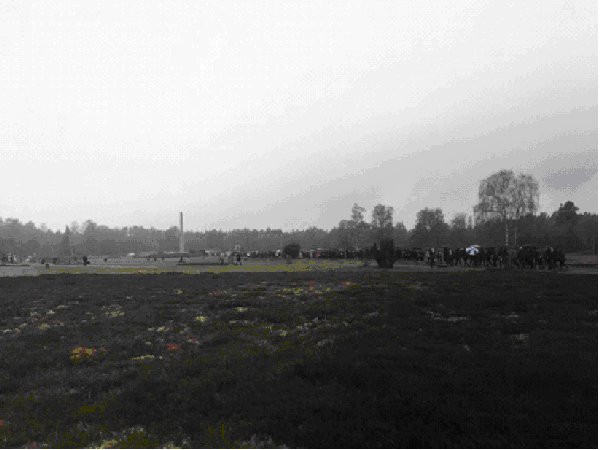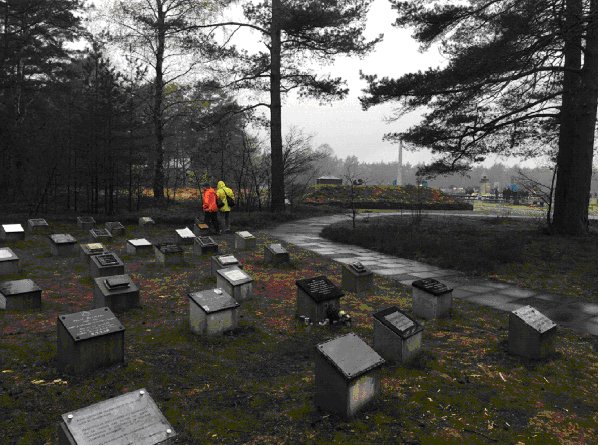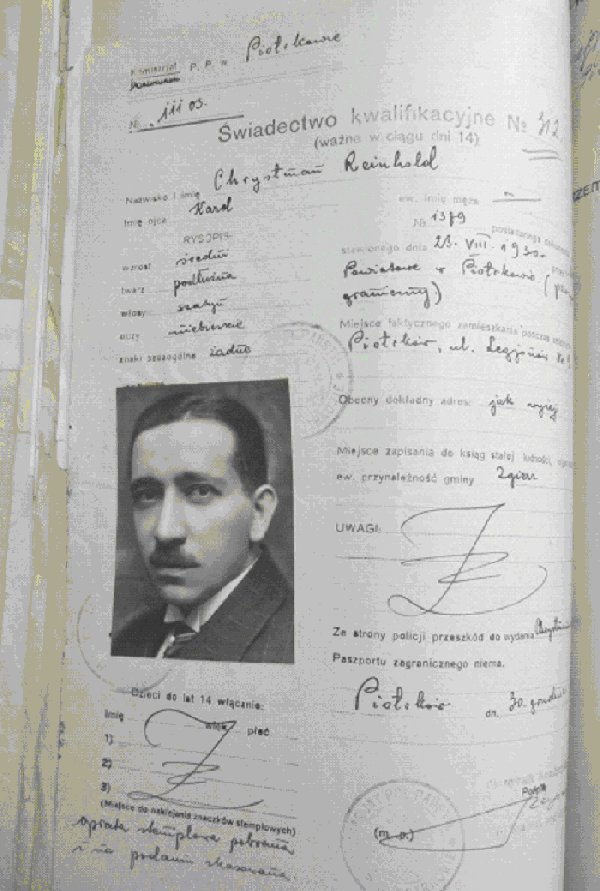| |
2015 |
|
| Browse our
|

The Search for Reinhold Chrystman By Jerry Klinger Righteous Among the Nations Ultimately, It is the individual who redeems the world, not governments or institutions.[1] 1941, my father, Fritz Klinger, was sold by the Vichy French as slave labor to French entrepreneurs. He was not French. He was an Austrian Jew. He, like many German/Austrian Jews, was a refugee who sought shelter in France to escape the Nazis. Many ended up in the French Concentration camp system along the Pyrenees in South West France. The largest of the French Camp was Gurs, about 50 miles from the border. It was not built for the Jews. It was built for the Spanish. It was fully operational by 1939. Spanish refugees, trying to escape the Spanish Civil War (1936-1939), had crossed illegally into France. The French did not want them. France built a string of internment camps to hold the Spanish. When the war ended and the Spanish were repatriated, the camps remained standing. They remained standing ready for use by their new occupants, the Jews. By 1940, Gurs[2] held over 4,000 Jews. The French identified them as enemy aliens. My father was not in Gurs. He was in a seaside resort town, Argeles Sur Mer, a sub- camp of Rivesaltes. He was a Jewish slave laborer building the roads along the Mediterranean. His reward was severe beatings and horrific abuse by his French overseers. France had been stunningly defeated by the German armies in a lightning victory. Free France ended in months after World War II began. France completely surrendered to the Germans in June 1940. France was divided. Most of Northern France, divided roughly along the middle, came under direct German control. Southern France became Vichy, allied to Germany under the famed World War I French leader, Marshall Petain. Hundreds of thousands of French soldiers languished in German prisoner of war camps. The French war prisoner's health, their welfare, their lives, was conditional upon French cooperation and subservience to their new German masters. A directive came down from the Gestapo and German high command to the people of France. It was a deal so evil not even the Devil could have thought of it himself. The Germans offered to exchange a French war prisoner, one son of a French family for every Jew that was turned over to them. Vichy France was filled with foreign Jews, enemy aliens. They were not French, they were foreign Jews. My father, being an Austrian Jew, having no family in France, no French connections, was traded to the Germans. He was sent to Drancy, just outside Paris, in 1942. The French rail system ferried him to the Germans and Auschwitz. Three years later, near death but saved by an unknown after being bayoneted on a Death March to Buchenwald, he was liberated by the American army under General Patton. My wife and I have more than once sat at the table discussing the "deal" the Germans gave to the French. Would we have traded a foreign Jew, a refugee, someone we did not know personally if we could get our son back from the Germans? Would we offer the life of the stranger in our midst to get our son home safely? Would we bargain with the Devil for our son's life? We both knew the answer. It turned our stomachs. It made us shiver at the thought of possibly committing the murder of a stranger to save our son. We both knew what we would have done. We would have traded the Jew to get out son back. What if a stranger, a wanted enemy of the State, a Jew, perhaps a Jewish family, knocked on our door late at night, terrified and destitute? They begged for help. They begged for a little food. They begged for a little human mercy. What would we have done? Helping the Jew could mean the Germans or the local police may be alerted by a neighbor eager to collaborate. They could come and kill us or our children for even offering a little bread to the baby being cradled in its mother's arms. Would we still help? My wife and I like to think we would. We like to think we would risk a little. Maybe not to the level of bringing the Jews into our home and hiding them but maybe helping a little and quickly sending them on their way. Yet there were people, non-Jews, who did open the doors of their home to fleeing Jews. There were non-Jews who offered shelter, safety and refuge, completely aware of the consequences. Some helped long term, even for years. Many helped Jews temporarily, simply giving them food, money, transportation or guidance to another shelter. Some knew the Jews they were helping. Many had never met the Jews before or had even considered helping Jews until the desperate soul showed up on their doorstep. Yet they did. Some paid the full price that the Germans and their collaborators demanded for helping Jews - death. Why did they help? Why did they risk all for strangers when they knew it was extremely dangerous? The reasons were all over the place. Some risked all because of deep religious faith and the sanctity of life, all life. Some did what they did because they hated the Germans. Some risked all because at that immediate moment of time, something inside them demanded they help. The choice was theirs. The decisions were personal, individual. The decisions to help came from something inside, instinctive. They did not have to be told what was right or wrong. They knew. Yad Va'Shem was created in 1953 by Israel's Parliament, the Knesset, as Israel's national historical memory of the Holocaust. In the law's preamble, a specific obligation is mentioned. It was an acknowledged obligation to remember, to find, to honor those non-Jews who chose to save Jews during the Holocaust, the Righteous Among the Nations. Nine years later, as the Yad Va'Shem memorial continued to evolve and its search for memory developed, the process for and acknowledgement of the Righteous Among the Nations expanded. A public commission was created to oversee the effort, the Commission for the Designation of the Righteous. The Commission is always headed by a Supreme Court Justice. The first was Justice Moshe Landau. A year earlier, Landau presided over the trial of one of the most monstrous, yet banal, Nazi war criminals, Adolf Eichmann. The second head of the Commission was Moshe Bejski. He had been saved by Nazi party member and war profiteer, Oskar Schindler[3]. Schindler, like many of the Righteous, had not started out to be such. Something inside of him compelled him to risk everything to save over 1,000 Jews. The Commission defined a set of conditions before a person could be designated a Righteous Among the Nations. 1. Active involvement of the rescuer in saving one or several Jews from the threat of death or deportation to death camps 2. Risk to the rescuer's life, liberty or position 3. The initial motivation being the intention to help persecuted Jews: i.e. not for payment or any other reward such as religious conversion of the saved person, adoption of a child, etc. 4. The existence of testimony of those who were helped or at least unequivocal documentation establishing the nature of the rescue and its circumstances.[4] Nothing like the Righteous Among the Nations had ever been done in the world. It was unique then and remains unique today, sixty two years later[5]. No country, no museum, no sub-section of a national museum anywhere in the world was willing to recognize and honor, with deep gratitude, people who had chosen to save the lives of strangers at the risk of their own lives when they could have, justifiably, reasonably, turned their backs. The Righteous Among the Nations program has recognized, with honor and deep respect, over 25,000 people. The Righteous have come from seemingly unassociated countries around the world such as Vietnam to the more expected countries such as Poland. Rescuers have come from 53 countries.[6] There are rescuers who have chosen to remain unknown. There are others who are still not known. In Hebrew we have two words with seemingly contradictory meanings, Mikreh and Beshert. Mikreh translates roughly as coincidence. Beshert is a totally different concept. It means intended. In other words, the concept of Beshert has to do with a destiny driven by fate or by God. Nothing happens that is unintended, nothing is a coincidence. It is a debate centered in theological issues. April 26, 2015, I attended the 70th anniversary of the Liberation of the notorious German Concentration camp, Bergen Belsen. I had last been there twenty years earlier as a guest of the German government. My mother and her sisters were liberated by the British in Belsen. My grandmother and my grandfather died and are buried in one of the mass graves at Belsen. There are no original physical structures of the camp left. The British burned everything after the bodies were buried to control the typhus that was killing the survivors. Twenty years ago there was only a small visitor's interpretive center at the entrance. The empty, vast camp grounds are interspersed with many enormous, tall burial mounds. The stone bases of the burial mounds are framed in stone with central wording, Heir Ruhig. here rest 1,000 dead. 5,000 dead.
 Burial Stone
 Burial Area On this cold and rainy day, thousands of people came to Belsen to remember and pay respect. In the twenty years since I was last at Belsen, the German Government has built a major interpretive museum and educational center at Belsen. The museum's presentations do not leave anything to the imagination. It does not gloss over or sanitize what happened there.
 Memorial Garden - Jewish Memorial in background set against a mass grave One other significant change was nearly hidden in a small copse of trees off to the side of the original Jewish memorial erected on the grounds in 1946. It looked like an impromptu memorial garden of personalized tombstones. It was not there twenty years ago. I returned to the Belsen Museum and spoke with Kurt Taetzler, a curator and archivist at the Belsen asking about the unusual memorial garden area. He explained the small stones were placed by family of those who had died in Belsen. They wanted to give personal memory to those impersonally bulldozed into the mass graves. I asked if I could place two stone memories for my grandparents, Yacob and Machla Braun. They were from Lodz. They are buried, somewhere, on the grounds. German records were meticulous. My grandparent's names were found amongst the listed dead. Permission to place stones of memory was given within a few weeks. The stones will be placed the end of August. They will have what everyone is entitled to - memory. Taetzler asked me if my family had any testimony of their time in Belsen. He wanted materials for the Belsen archives. Knowing only vague stories, I promised to do what I could. Of my mother and her three sisters, only one Aunt still lived. She is far from well. Fifteen years ago, she had written her unpublished memoirs of her, and my mother's family's, wartime experience. I wrote to a cousin who forwarded me a copy of her memoir. She had written extensively of Belsen. She had also written of their lives in Lodz and how they had moved to Piotrkow because they thought it might be safer. It was a 270 word paragraph on page 35 of the memoir that began an incredible journey in search of a potential, previously unknown, Righteous Among the Nations. My family had been workers in the Piotrkow's Kara-Hortensja Glass factory. I had heard stories of the factory from my mother but nothing that a kid understood or cared to remember in detail. My interests were not Holocaust centered, rather the today of any kid, music, girls. life. By the time I did understand and want to know more about the Holocaust, my mother lived no more to tell me about it.
 Reinhold Chrystman My family had not just been workers in the factory according to my Aunt's memoir. They were intimately involved in the organization and operation of the Jewish part of the Kara-Hortensja factory. Zenio Gomberg was the plant's Jewish operational connection. He reported directly to the plant manager, Reinhold Chrystman.[7] It was the fall of 1944. My Aunt wrote their lives had been saved by Reinhold Chrystman, a Christian. It was an unbelievable, unknown story. "About that time my brother-in-law Zenio Gomberg came up with the idea that we should have a book with everyone's name engraved in it, covered in a white leather binding, which the internees of Kara-Hortensja would present to the owner, Christman, for having saved our lives. He was, like Schindler, a Volksdeutsche who used slave labor in order to protect his son from being sent to the Russian front. The project began immediately. There were talented people among us and they created a beautiful masterpiece. It was a white leather book inscribed on the cover with gold lettering, stating that the inmates of Kara-Hortensja dedicate the book to Christman for saving the lives of about 700 Jews. Inside the long, narrow book the name of each person living and working in Kara-Hortensja was engraved in beautiful script in gold letters. Each individual signed his name also. This book was presented to the owner of the glass factory in the presence of those working inside the compound. The book saved the life of Christman and his family after the War. What better evidence could he have than the grateful acknowledgment of his slave laborers?" Was the story true? No doubt my Aunt had been telling her truth about what happened. But was the story true? My academic background in historical research compelled me to investigate, to cynically confirm the story. My Aunt's memoir became an academic, historical mystery, a search for the truth. I wanted to believe it. But.. A mystery can be fictional. A mystery could also be true.. The search began online with Yad Va'Shem. They had no record of Chrystman. Extensive research at the U.S. Holocaust Museum in Washington, D.C. followed. I pored over the records from the Piotrkow Survivors journal edited by Ben Giladi. Hours of Spielberg's Shoah Foundation Testimony were viewed. I reached out to anyone who had written about Piotrkow. I scoured the records of the Mormon Family research centers in Kensington, Md. Little by little, the fog of history peeled away. Documentary evidence about Chrystman, living testimony emerged from the Shoah Foundation's recorded interviews specifically identifying Chrystman as he risked his life to save individual Jews. I spoke with survivors. Some knew Chrystman though they were small children in the factory at the time. Chrystman managed every detail of life in the sprawling Kara-Hortensja Glass Factory. He employed large numbers of Poles and over 700 Jews. He strangely employed an unusual number of young Jews, little more than children, in the factory. They were designated as "essential skilled workers". How essential and skilled could a fourteen year old child be? Chrystman established a mini-nursery within the factory. He employed a young Jewish woman whose sole job was to supervise and take care of the needs of 8-9 children, ages 2-10. She testified in the Shoah Foundation tapes. Two of those children are my first cousins. The nanny continued in her Shoah testimony with an astonishing story. She spoke with pride of specifically having taken care of a very little boy in the sheltered nursery of Chrystman's factory. The little boy's name was Israel.Israel Lau. He would survive and grow up to become the Chief Rabbi of Israel, Rav Israel Lau. I spoke to Rav Lau. He did not know about this part of his life. He assumed he had been a tiny worker in the factory. He said he did not remember anything because he was just a very young child. And he was. I shared with him how we believe his life had been saved by Reinhold Chrystman. Having established contact with the director of the Righteous Among the Nations program, Irena Steinfledt, a key question hung out like a broken thumb. Why did Chrystman do what he did? It is a fundamental question. It is a reasonable question. It is a must question. I did not have an answer. A clue came from Chrystman's Piotrkow identity papers. Chrystman identified his path to God as Baptist. He was a Volkes-Deutsche, a German in Catholic Poland and a Baptist. I wondered if there was a religious motive behind his actions. His being a Baptist, unusual enough in Catholic Poland, was not proof of anything. Chrystman emigrated from Austria to Brazil in the late 1940's. His first wife separated and moved to Canada. He lived with his other family in Brazil and died there in the 1960's. Perhaps it was incredible good luck and hard work, or perhaps it was beshert, I managed to find Chrystman's great Grandson in Canada. Fascinated and sincerely engaged, he promised to write to his Aunts. The family knew very little about their history and their grandfather. Gaps existed in their memories. A remarkable email came from the Philippines from one of Chrystman's granddaughters. I recognized the language of an Evangelical Christian. She briefly described her grandfather as always reading his bible. She described vague family stories of how her grandparents had saved Jews. They had always thought he sent Jews to Switzerland to safety. They knew he managed a glass factory in Piotrkow but had no idea of his role there. The granddaughter spoke of her love for God's chosen people and promised to search further. A second granddaughter in Brazil also offered to help. The implication was direct. Chrystman's motives may have been religious. The word is may. Corroboration is more than implication. Further proof is needed. Contacting a friend, Pastor Werner Oder, an Evangelical Pastor in England, I asked for his help. Werner and I have become close friends. He is a sincere, firm, energetic supporter of Israel. He has been made to pay dearly for his support of Israel and the Jewish people by his community and his own family. Pastor Oder's father was a particularly odious convicted Nazi War Criminal, Wilhelm Oder. Werner contacted the Polish Evangelical community on my behalf. Pastor Ozana contacted me and offered to help. The Baptist community in Lodz and in Piotrkow is no more. After the war, the Volkes-Deutsche emigrated to Germany and Austria. Pastor Ozana has begun an outreach to Evangelicals in Poland and Germany to help research Chrystman's story. History is not tidy. It is not a mystery novel where all the loose ends are tied together in the last pages. Why the Righteous Among the Nations did what they did is not always, absolutely, 100% clear. All people, Jews, non-Jews, do things because of something inside them. Righteousness could come from faith. It could come from the soul. It could come from their humanity? And sometimes, because of fear, intimidation, or the lack of something inside of them, they cannot or will not. Why many of the Righteous Among the Nations did what they did remains an enigma except for the fact they did them. After nearly 70 years, time has covered over so many voices who could speak for or about Chrystman. The weakness is not individual confirmation of his having saved Jewish life, that is plainly recorded in the Shoah Foundation testimonies and works from Sir Martin Gilbert and other secondary materials. The weakness is is there contradictory testimony that has not been discovered? Was Chrystman a Schindler? There are parallels and differences. Schindler was a Nazi party member. Chrystman was not. Schindler relocated his Jews and his factory. Chrystman could not relocate his factory and could not relocate his Jews. Did Chrystman save 700 Jews as my Aunt wrote? So far, that aspect of the story is not conclusive. Help is needed, much needed, much wanted, before justice and memory is possibly given to Reinhold Chrystman as a Righteous Among the Nations. Jerry Klinger is president of the Jewish American Society for Historic Preservation. He can be reached at Jashp1@msn.com [1] Rabbi Mordechai Schreiber, pg. XII, Saving the Jews, Mordecai Paldiel, Schreiber Publishing, Rockville, Md. 2000 [2] http://www.ushmm.org/wlc/en/article.php?ModuleId=10005298 [3] Oskar Schindler died in 1974, broke and virtually alone. The SchindlerJuden had repeatedly attempted to help him. His war experiences had broken him beyond repair. Even the gold ring fashioned from the gold taken from the teeth of some of his Juden, he sold for drink. He is buried in Jerusalem, as was his wish. [4] http://www.yadvashem.org/yv/en/righteous/faq.asp [5] http://www.yadvashem.org/yv/en/holocaust/insights/video/righteous_program.asp#!prettyPhoto [6] http://www.yadvashem.org/yv/en/righteous/statistics.asp#explanation [7] Chrystman is spelled a number of different ways in documents - Chrystmann, Kristman, Christman. from the 2015 Edition of the Jewish Magazine Material and Opinions in all Jewish Magazine articles are the sole responsibility of the author; the Jewish Magazine accepts no liability for material used. |

|
| All opinions expressed in all Jewish Magazine articles are those of the authors. The author accepts responsible for all copyright infrigments. |



